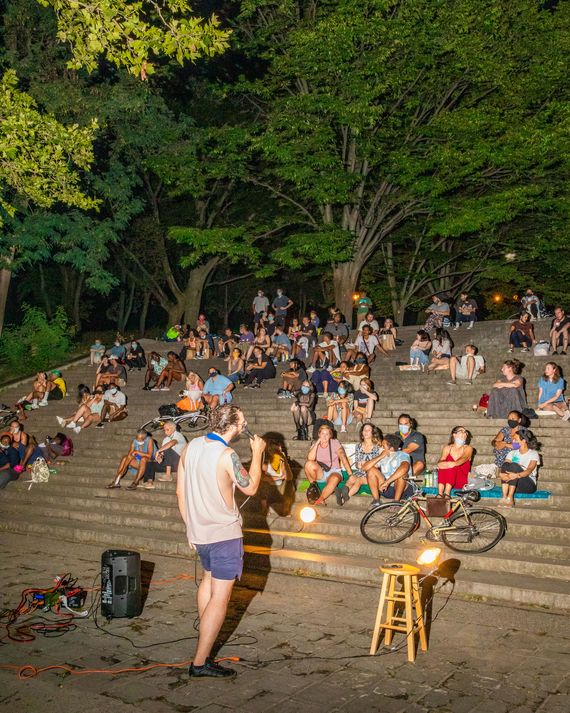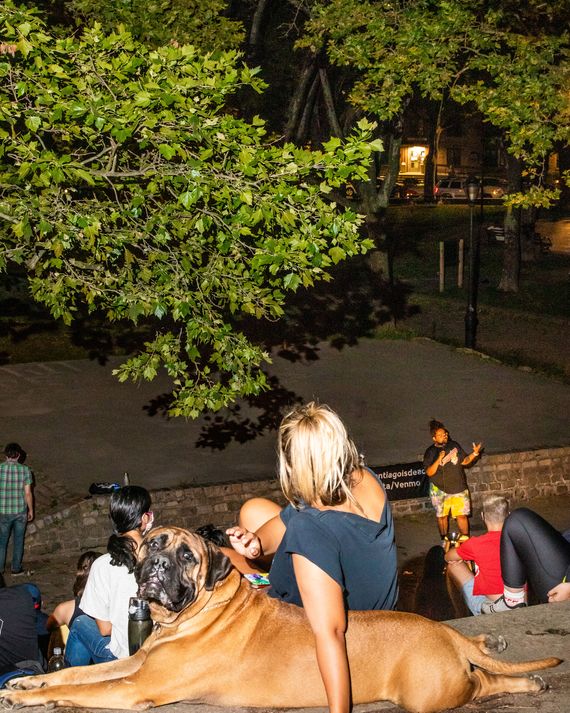
Lately, it’s felt like a part of New York has left—the part that gave you the feeling you could go anywhere, at any time, and discover something unexpected happening in the city. The summer has brought back some illusions of normalcy, but what hasn’t returned is that sense of freewheeling abandon. We are left with population density and air density. But on a recent Tuesday, it rained. And Wednesday night, air clear, I went to an outdoor comedy show.
“Take It Outside Comedy,” a pop-up stand-up showcase thrown twice a week in Brooklyn by comedians Daniel Louis Vezza and Santiago Angel, is part of a growing trend of outdoor comedy in the city, including shows at Stand Up NY in the Park and at Astoria’s 55-year-old Bel Aire Diner, which now hosts comedy at its parking-lot drive-in theater. The “Take It Outside” shows are closest in walking distance to my home—the ease of access is part of the allure—and even though I knew where I was going, it felt as if I’d just stumbled upon 100 people scattered on a set of steps waiting for something to start.
The show was a comedy show; some people did great, some not so great. Most were charming. Everyone was rusty, the crowd included. Unlike, say, musicians, who can use the extra time at home to practice, stand-ups need audiences to write. It was the first show in months for Isaiah Lorenzo, who noted apologetically, “I don’t know if these are punch lines. I’m just saying statements.”
Being outdoors presents another set of problems—most noticeably on that night, three middle-school-age hecklers interrupted every joke for the first 15 minutes of the show. Also, you don’t think about how important ceilings are until there aren’t any. Comedy benefits from trapping the laughs in, allowing one joke to ride off the momentum of the previous one. When that’s not possible, laughs float away into the air. (Not a single performer’s closing joke worked.) Comedian Maddy Smith handled both of these issues well. First, while most acts were more conversational, as is the fashion, she told punch-line-driven jokes with clearer cues for laughter. Then, with a combination of sexually explicit material and dom-like energy, Smith made the middle-school boys leave, bashfully, upon which we cheered. We were a mob for a minute.
I wasn’t sure we’d be able to top celebrating the embarrassment of 12-year-olds until Sean Patton took the stage. The most experienced stand-up on the bill, he could see something the others had missed. A lot of comedy involves (1) identifying unusual/uncomfortable things and (2) finding ways to relieve the tension associated with No. 1. The more significant No. 1 is, the greater the difficulty and potential reward of landing No. 2. Throughout the show, the problem with talking about the pandemic was that, as a topic, it’s too unpleasant to laugh at easily and doesn’t feel unusual at this point.
Patton quickly clocked what was unusual: that we were all gathered outside watching a comedy show. Naming this the “frontier,” he pointed out how comedy functions in relationship to its context. Comedy clubs are agreed-upon spaces where we allow comedians to say whatever they want. But now we have, as Patton called it, “filthy hoo-ha talk” floating into the air for anyone to hear. “I don’t get offended by humor,” he explained, “but when you hear ‘cunt’ echoing off trees, you’re like, Hmm, this is interesting. We’re pushing it.”
*This article appears in the August 17, 2020, issue of New York Magazine. Subscribe Now!



